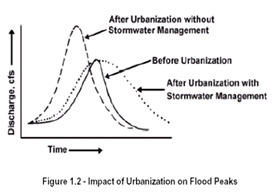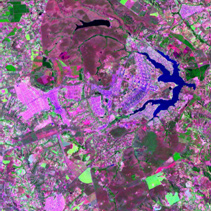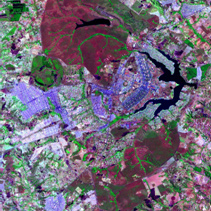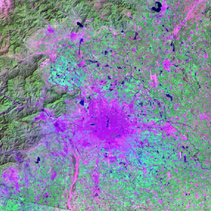|
|
WATER IN LANDSCAPE Combined effects of urbanization, industrialization, and population growth greatly modify landscapes and thus the continuous circulation of water within catchments and the Earth's hydrosphere - the hydrological cycle. The hydrological cycle control several processes in the landscape (e.g., transport of pollutants, water chemistry, pattern of nutrient fluxes, erosion, surface and groundwater levels), and thus some of the ecosystems features (e.g., rate of productivity, decomposition) and processes (e.g., rate and pathways of matter circulation). Functioning of ecological processes in the whole catchment depends on the water cycle reflects in the quality of aquatic habitats and ecological stability of their ecosystems. URBAN DEVELOPMENT SIGNIFICANTLY CHANGES THE HYDROLOGICAL CYCLE.. The main changes of the physical pathways of the water cycles due to urbanization include:
Therefore, although the hydrological cycle consists of the same elements, their proportions in urban area are significantly different:
Urban development significantly increases the amount of storm water and the frequency of extreme hydrological events experienced by the City's catchments. The increased runoff causes more intense local flooding, while droughts during dry weather are deeper and longer. Runoff amounts typically for 10-20% of the average annual rainfall in rural areas.
In urban areas, where surfaces are highly impervious, typical runoff volumes range between 60-70% of the average annual rainfall.
These changes impact strongly water habitats: increased discharges erodes stream beds and banks, exports high concentrations of pollution into the rivers, wetlands and reservoirs, destabilizes ecological processes, handicap ecological stability of ecosystems. All this not only reduce aesthetic values of the city, but also restrict provision of ecosystem services and causes water-related problems to the urban population, related to flood risk, water supply, drainage, wastewater collection and management. GREEN SPACE IN CITIES AND THE HYDROLOGICAL CYCLE Cities expansion usually reduce green spaces areas. The satellite pictures show the overall look on two big urban areas: Brasilia and Beijing, and the changes within greens peace areas which accrued during a decade (green colour).
In some cites however, green space covers larger areas than built and paved spaces. In Vienna, only 32.8% of the city is classified as built-up, whilst green spaces cover 48.8% of the city's surface area when farmland and woodlands on the urban fringe are included. Similarly, two thirds of Oslo's surface area consists of woodlands and farmland. In other cities, the proportionate cover of green spaces can be considerably lower. According to land use statistics, the proportionate cover of green spaces is below 40% in Munich. However, the figures are difficult to compare as the proportionate cover of green space varies depending on how much of the surrounding countryside is incorporated within the municipal boundaries.
Development of green areas in cities mitigate the negative impact on the hydrological cycle and improve the quality of the environment and quality of life in cities. Increased water retentiveness of catchments improves flood protection, quality of water, environment and aquatic ecosystems. Open water spaces and green areas improves microclimate providing better environment for people, increasing population health, providing recreational spaces. References: |
||||||||||||||||||






